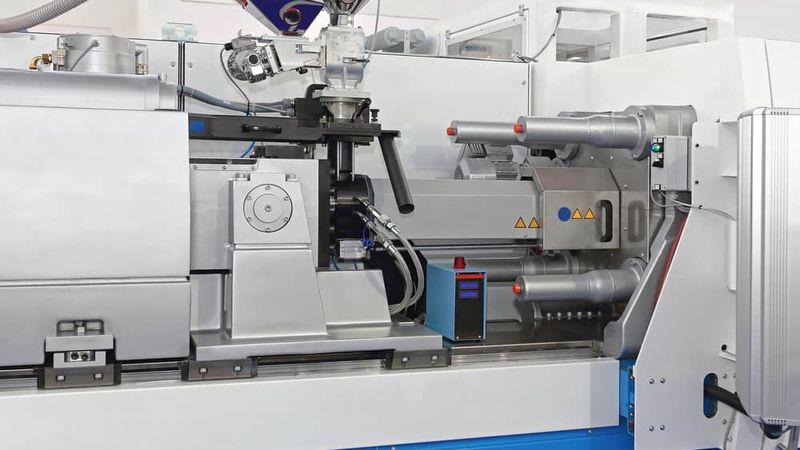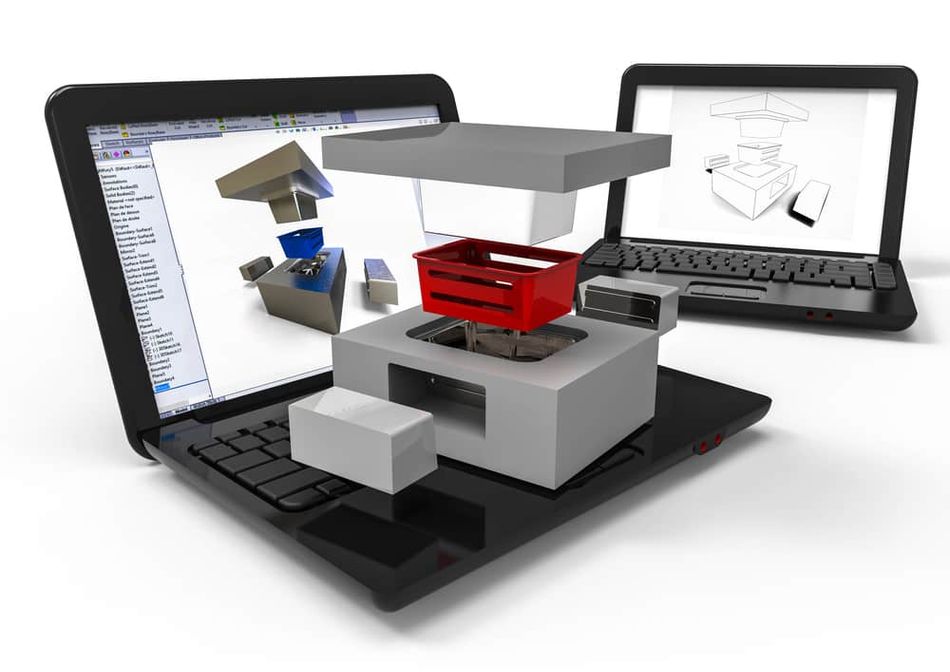Draft angles in plastic injection molding
Injection molded parts need to have angled walls so they can be ejected from the mold without getting stuck. This article looks at how to incorporate draft angles during part design.

An industrial injection molding machine
The injection molding process is one of the manufacturing world’s most powerful resources. Used to make duplicate parts in massive quantities, injection molding is fast, cost-effective, and compatible with many plastics, including thermoplastics, thermosets, and elastomers.
However, injection molding is subject to strict design constraints. Injection molded parts must have thin walls to prevent warpage and deformation, and designers must consider the placement of parting lines, gates, and other features that enable the process to work properly. This can have a negative impact on the cosmetic finish of molded parts, with marks and excess plastic often visible.
One of the most important design for manufacturing (DFM) considerations for molded plastic parts is draft. This article looks at the meaning of draft in injection molding, how to incorporate it during part design, and why it is essential to successful moldings.
What is a draft angle?
In molding part design, a draft angle is a taper applied to a vertical wall of the mold, facilitating part ejection. The taper runs perpendicular to the parting line so that the opening length and width are greater than the corresponding internal dimensions.
For example, if molding a cylindrical shape, the circular face at the parting line should have a greater diameter than the circular face at the bottom of the mold, allowing the finished cylindrical part to pop out of the mold. An equivalent part without taper may scrape against the walls of the mold as it is ejected due to the friction between the metal and plastic surfaces.
A draft angle is typically specified in degrees, though it may also be measured in mm/mm. In technical drawings, it is common practice to specify only the length and width of the mold opening, the depth, and the draft angle, as opposed to the length and width of the opening and the (smaller) internal length and width.
Benefits of draft angles
The principal purpose of injection molding draft is to enable fast and safe ejection from the mold. However, there are other benefits too.
Easy part ejection
When the vertical walls of a mold are tapered, it is much easier to eject the plastic part once the molding cycle is complete.
This is because the plastic within the mold experiences shrinkage as it cools and hardens, causing it to seal tight to the core side of the mold. If no draft is used, the walls of the part will scrape against the inside walls of the mold during ejection, potentially causing warpage.
Smooth ejection also means shorter cycle times, which in turn means a lower production costs.
Tool life
Preventing the molding from scraping the mold walls during ejection is good for the part and also for the mold itself. Draft prolongs tool life by minimizing friction and scraping on the inside walls of the mold, maintaining its smooth and even surface. Retooling costs can be very high, so molders should do everything possible to prolong the life of the initial mold.
Part surface finish
By minimizing contact between the mold and the molding during ejection, a good surface finish can be maintained on the molded plastic parts. This is important because mass produced molded parts are not typically subject to rigorous post-processing steps like polishing, so the “as molded” finish should be as good as possible.
Drawbacks of draft angles
The drawbacks of incorporating draft are perhaps more obvious than the benefits. First and foremost, the inability to use completely vertical walls — except in certain circumstances — can significantly hinder the function of certain parts. When parts with perfect right angles are required, product designers often seek alternative production processes.
Another drawback of draft is the complexity of determining the minimum required angle, as several factors affect the required taper.
Calculating draft angles
A general rule of thumb during injection molding design is to add between one and two degrees of draft for every 25 mm (1”) of cavity depth. However, other factors such as molding material, wall thickness, and mold surface texture can affect the required draft angle.
Material
The choice of injection molding material can affect the required draft angles during the design process. For instance, softer materials like nylon can have lesser draft requirements than harder materials like polycarbonate, as they exhibit some pliability during part ejection. Additionally, materials that exhibit very high shrink rates require more draft during product design as they are more likely to cling to the mold during cooling.
The table below indicates to what extent draft angles can deviate from the standard 1–2° depending on the molding material.
Material | Draft angle adjustment |
Nylon | -1° |
PVC | -0.5° |
PP | 0° |
PC | +0.5° |
Surface texture
An equally important consideration when specifying draft angles is the use of textured surfaces on the interior walls of the mold. Glossy parts require the smallest draft angles, parts with light texture require slightly greater angles, while parts with a heavy texture like a leather effect require even greater angles.
As a rule of thumb, add an extra 0.5° of draft for every 0.1 mm of surface texture depth.
Surface finish | Draft angle adjustment |
High-gloss | -0.5° |
Light texture | +1° |
Heavy texture | +3° |
Cosmetic parts
The minimum draft angle for cosmetic parts can be greater than for non-cosmetic parts. For instance, high-quality transparent parts such as housings for electronic devices often require a greater draft angle to prevent scratching, which would compromise the appearance of the moldings. On the other hand, small imperfections caused by ejection force are acceptable for most functional parts.
Minimizing or avoiding draft
In some circumstances, the recommended draft angle for a design may be unacceptable as it would compromise the function of the part. If the part cannot be redesigned to accommodate draft, there are a few workarounds for minimizing or removing draft angles.
Ejection-friendly materials
On the whole, softer materials — nylons, for example — are easier to eject than harder ones, so using them may offer some leeway in terms of draft angles. With additional measures such as the use of release agents, nylon parts can be molded with a draft angle of zero.
That being said, highly flexible materials can buckle or deform during ejection, ultimately lengthening the cycle time. In fact, a larger draft angle of at least 3° may be required for thermoplastic elastomers.[1]
Release agents
Molds with low or zero draft can be assisted with lubricating mold release agents (also known as anti-blocking agents, parting agents, or surface lubricants). These special additives can be applied to the inside of a mold (or to the molding material itself) prior to the injection of the molding material, reducing friction between the metal and plastic surfaces.
Some release agents are semi-permanent, lasting for several molding cycles before reapplication is required, while others are used up with a single shot.
Not all mold release agents work in the same way. Some release agents are sprayed directly onto the tool steel of the internal surfaces of the mold. Such agents include silicone and certain fluorocarbon-based materials. However, other release agents are applied to the molding material itself.[2]
A limitation of release agents is that the additive can end up coating the surface of the finished molding and make it resistant to gluing and painting, either of which may be necessary to prepare the part for its end use.
Actions
Draft angles are important for straight-pull molds, i.e. two-part molds comprising a core and cavity. However, more complex mold types offer greater design possibilities.
Special inserts or actions can be used within a mold to achieve a wider range of geometries. For example, side actions are often used to accommodate geometries with undercuts, but they can also be used to reduce draft angles.
Alternative processes
Draft is required to facilitate ejection. Manufacturing processes that do not use ejection therefore do not require draft angles during part design.
Additive manufacturing (3D printing) and CNC machining are both viable ways to make parts with straight walls, though they are more expensive than injection molding when it comes to mass production. Extrusion is another way to make undrafted parts, though these parts must have a consistent cross-section, limiting the possible geometries.
Key takeaways
Draft is an essential feature of injection molding part design. Without incorporating draft angles, part ejection becomes problematic, often leading to slow cycle times, damaged parts, and worn tooling.
Unfortunately, the myriad factors that can affect the minimum required draft angle can make part design a lengthy process. This has led researchers to develop tools for automatically calculating draft angles, though these are not widely adopted.[3] Meanwhile, tech giant Apple once applied for a patent for a zero draft molding process to be used in the production of styluses for tablets and other personal electronic devices.[4]
If in doubt about the draft angles required for a design, consult an experienced injection molding specialist.
References
[1] Drobny JG. Polyolefin-based thermoplastic elastomers. Handbook of Thermoplastic Elastomers. 2014;2014:209-18.
[2] Coleman EA. Plastics additives. InApplied Plastics Engineering Handbook 2017 Jan 1 (pp. 489-500). William Andrew Publishing.
[3] Jong WR, Li TC, Chen YW, Ting YH. Automatic recognition and construction of draft angle for injection mold design. Journal of Software Engineering and Applications. 2017;10(01):78.
[4] Berg BE, Stringer CJ, Aune G, Brooks RP. Zero draft mold. US20150367545A1. 2014.

